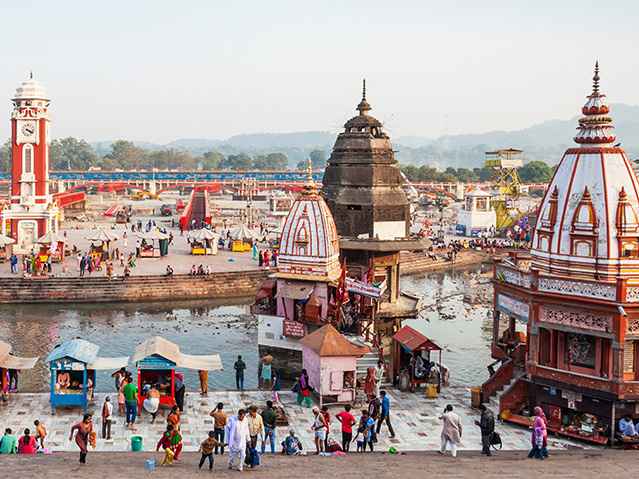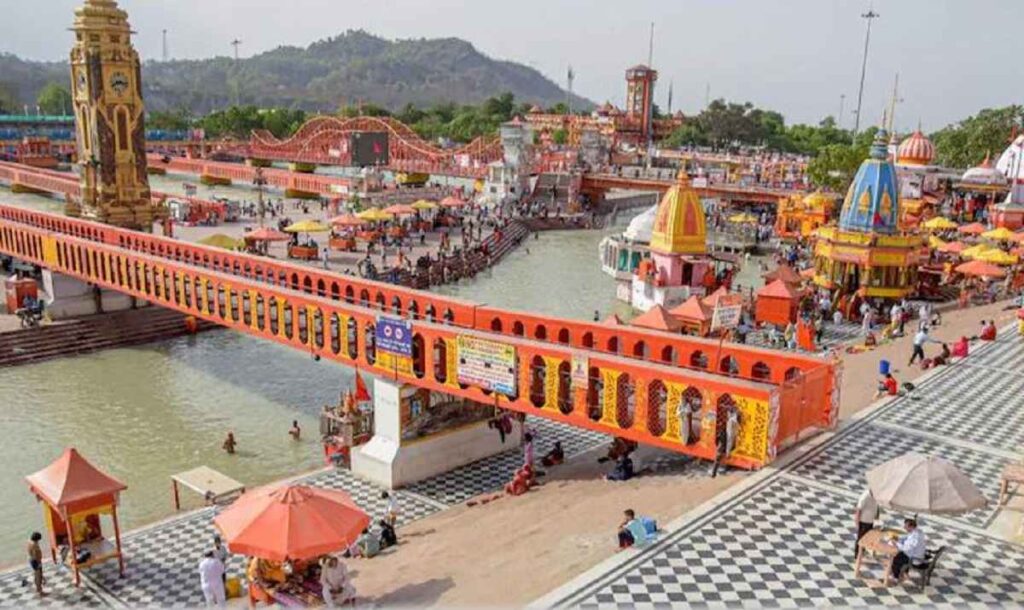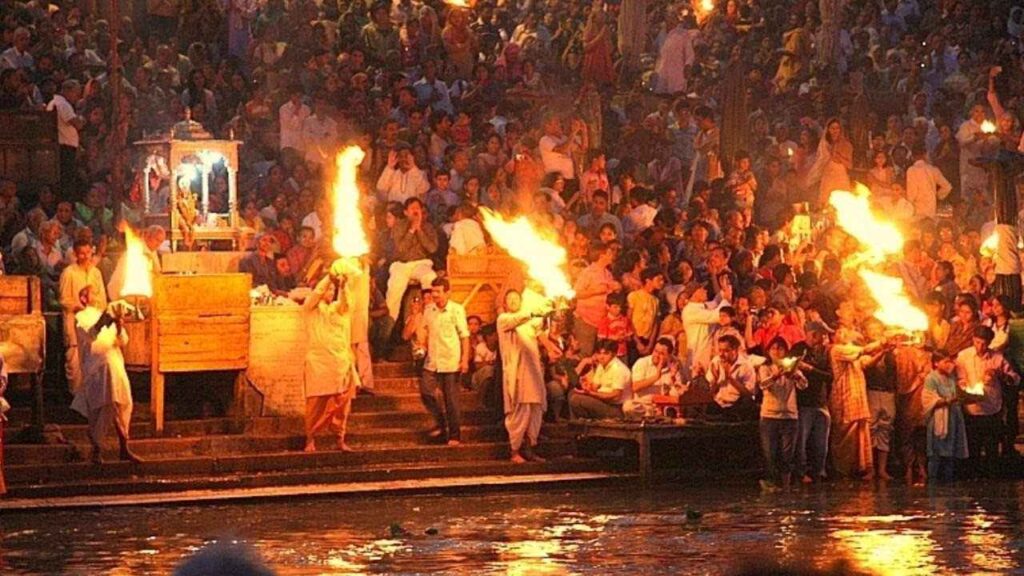India is a country of many religions and vast cultural diversity, with the majority of its people ardently following Hinduism. Due to this, India has a vast number of religious places across its landmass. Among these, Haridwar is a city of extreme religious importance. Within Haridwar, Har ki Pauri is a famous place of religious importance, thus attracting tourists and pilgrims from all over the country and even abroad. It has become the most visited spot to experience the famous Ganga Aarti of Haridwar. Situated in the state of Uttarakhand, Har Ki Pauri is a famous ghat of the river Ganga, where people come to experience the culture of Hinduism and the famous Ganga aarti.
If we translate the name “ Har ki Pauri “, Har means Lord Vishnu, and Pauri means steps. This translates the meaning in English as “ Lord Vishnu’s steps”.
Before this ghat, the river Ganga flowed from the mountains all the way from the Gangotri glacier. After this ghat, the river enters the northern plains and flows through the plains. The Har ki Pauri ghat is located on the western bank, and the river turns from the western direction to the north here.
The History of Har Ki Pauri
Bhartrihari was an Indian king who ruled the state of Malwa nearly more than 2000 years ago. In the latter part of his tenure as king, he left his kingdom to meditate on the banks of the Ganga in Haridwar. Legend says he meditated here for many years. In the meantime, his brother Vikramaditya had started ruling Malwa in his absence. After King Vikramaditya came to know about his brother’s death, he built the Har ki Pauri ghat to commemorate his brother, Bhartrihari. Records say this was around the 1st century BC.

However, what you see today, the numerous temples and ghats were not built until the 19th century. The extension of ghats was done in 1938 by a zamindar known as Pandit Hargyaan Singh Katara. He was an inhabitant of Agra. In 1986, a few more extensions were done by the har ki Pauri Samiti, aided by the state government.
Mythology Related to the place
According to Hindu mythology, Lord Vishnu came to the Har ki Pauri and left the impression of his feet there. This gave rise to the name Har ki Pauri. The name literally means the steps of Lord Vishnu.
There are other mythological stories revolving around Har ki Pauri. One such story is about King Svet. He is said to have done penance to Lord Brahma at Har ki Pauri so much so that Lord Brahma appeared before him and blessed him with a boon. King svet, being the devotee he was, asked for the place of Har ki Pauri to be renamed Bramhkund. The wish was granted, and to this day, the waters of Har ki Pauri are known as Bramhkund.
Another mythological anecdote exists. There was an event where the ocean was churned and an urn of nectar was released. Devashilpi Vishwakarma was the one taking the urn away with him when the gods and the demons were fighting to get it. While getting away, a few drops of the nectar fell onto Earth. The places where the nectar fell are said to be Haridwar, Ujjain, Prayag, and Nasik. This adds more religious importance to Har ki Pauri as it was the place where the drops of nectar landed in Haridwar. Legend states that the fight between the gods and demons went on for 12 years. For this very reason, every 12 years, the Kumbh Mela is organized in the aforementioned places. To bathe in the waters of the Har ki Pauri is the desire of every Hindu. It is believed that bathing in the waters of Har ki Pauri is the path to attaining salvation.
It is also said that during the Vedic times, Lord Shiva and Vishnu visited Har ki Pauri. The Hindu god Brahma has also been stated to have performed a ritual here.
Rituals and fairs are organized here
Being the spiritual center of India, Har ki Pauri attracts pilgrims throughout the year and organizes religious rituals here. These include mundan, upanayana, asthi visarjan, and pind daan. These are considered some of the most sacred rituals of Hinduism and are performed at this ghat.

Har Ki Pauri is a top religious place in the country, which explains why it’s busy throughout the year due to different fairs and melas. The most famous fairs organized here are the Kumbh Mela, Ardh Kumbh Mela, Kanwar Yatra, Magh Mela, and Vaishakhi. Pilgrims from all across the country visit Har ki Pauri during those times.
The ghat is open 24×7. It is never closed to people. It is a hub for devotees and solo travelers all day.
The time needed for Har ki Pauri
The time needed depends on the purpose of the visit. For a sacred bath at the river, one hour will suffice. The globally acclaimed Ganga Aarti is held between 4 pm in the afternoon and 7 in the evening. The atmosphere becomes surreal during the Aarti and sends chills down the spine. For a complete tour of all the temples near Har ki Pauri, it will take a whole day.
Best times to visit Har Ki Pauri, Haridwar
It is always better to plan while visiting a place as important as Har ki Pauri. It’s best to visit at 3 in the afternoon, as you can freshen up with a dip in the holy Ganges and witness the Ganga Aarti in the evening after your bath.
The place can be visited at any time of the year. Visiting before summer provides pleasant weather. The crowds are less during the monsoons, till it becomes a bit risky, and the visit will not be worth the struggle. The prime time for visiting is during the world-famous Kumbh and Ardh Kumbh Melas. Weekends and holidays are highly overcrowded at the Har ki Pauri.
The world-famous Ganga Aarti
The place is known for the aarti, so it’s vital to talk about its details. Being of great importance, the Aartis are offered in the morning during the Brahma muhurta, or the divine time, and during the evening. The evening aarti is very popular across the globe. The Maha Aarti starts after sunset. The priests hold the lamps in a grand and spectacular fashion and pray to Mother Ganges, chanting mantras in Sanskrit. Thousands of priests and brahmins take part in the aarti every evening, offering prayers to Maa Ganga, Lord Vishnu, and Lord Shiva. Ones who witness the Aarti have a divine and supernatural experience. It’s as if you reach another dimension and feel closer to your inner self and God.

The morning aarti during summer is held at 5:00 am. During winter, the time is postponed a bit and the aarti starts at 7:00 am. The evening aarti time also varies in summer and winter. During summer, it’s around 7, while in winter it’s significantly earlier at 5:30 pm with sunset.
The Aarti is broadcast live at the Shatabdi Bridge and the Kishawart Ghat through LED panels. This makes it possible for devotees who can’t make it to the Har ki Pauri ghat to witness the event.
Facilities provided to the pilgrims
The Har ki Pauri ghat provides all the necessities needed by a pilgrim visiting the place. Washrooms for both genders are provided along with changing rooms for those willing to take a dip in the river. Besides parking facilities, the ghat has clean drinking water and food stalls to grab a meal throughout the day.
How to reach
If you’re traveling by air, it is a bit complicated to reach the Har ki Pauri ghat. The nearest airport is Dehradun, and you have to travel 45km to reach Haridwar.
On the contrary, it is well-connected by railways all across India. It’s a 10-minute walk from the railway station.
Buses are available from all nearby cities to Haridwar. The bus terminus is 2km away from the ghat, and you can grab an e-rickshaw or an auto to reach the ghat.
After reaching Haridwar, it’s not difficult to find lodging, as the place is full of good hotels and Dharamshalas to fit your desire to stay. As a Hindu devotee, Har ki Pauri is a place one should visit in their lifetime. Being close to Rishikesh and Dehradun, it can also be merged into a tour of the two cities with a visit to the holy place.




